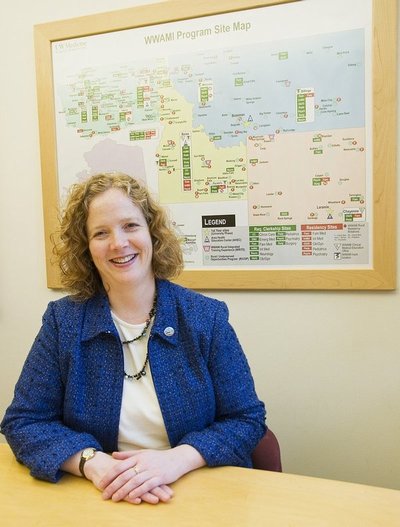April 8, 2010
Boise family physician Suzanne Allen takes the helm of the medical school’s regional programs
Dr. Suzanne Allen covers a lot of territory. Five state’s worth, in fact — a region that represents about 27 percent of the land mass in the United States.
As the new Vice Dean for Regional Affairs in the UW School of Medicine, Allen helps oversee the WWAMI program outside of Seattle. WWAMI, an acronym for the five cooperating states (Washington, Wyoming, Alaska, Montana, and Idaho) is a partnership between each state and the UW School of Medicine that provides access to publicly supported medical education across the five-state region. It began in 1971 as WAMI — when Washington was the only “W” among the initial four — and became WWAMI in 1996 when Wyoming joined the consortium.
Today, WWAMI is a unique medical school model in the United States comprised of six regional first year campuses — Seattle, Spokane and Pullman in Washington; Moscow, Idaho (which is a shared campus with Pullman); Bozeman, Montana; Laramie, Wyoming; and Anchorage, Alaska.
But across all of those states, “we only have four to five percent of the U.S. population, so we’re a very rural area,” Allen explains. “You can look at other medical schools around the country that have regional campuses that are in different locations, but those are always in the same state or the same small corner of a state. So we’re clearly the only program that is across that large of a region and that crosses state lines.”
WWAMI does not have “clinical campuses,” but required and elective clerkships in communities, hospitals and clinics around the region. Medical students complete their first year of medical school in their home state, their second year of training in Seattle, and their third and fourth years anywhere within the WWAMI region they choose to complete their clerkships. Students can select from a wide range of opportunities, depending upon the type of medical school experience they’re seeking.
“They really get to design their own medical education,” Allen said.
Whether students choose to focus on underserved populations in a large city such as Seattle or Spokane, or travel to Fairbanks, Alaska, to learn surgery, or to Lander, Wyo., to work with the Indian Health Service, they’re able to make their own choices in shaping the type of profession they hope to pursue.
“For a lot of students, this can be a career-changing opportunity,” Allen said, “to go spend time in a rural area or in an underserved clinic in a large city. I know several students for whom this has changed what they see themselves doing in the future.”
Originally from the Northwest, Allen attended medical school on the East Coast. She first became interested in working with rural and underserved communities during her time at Ellsworth Air Force base in Rapid City, S.D., which she describes as “essentially a small rural community of about 5,000 people on the base.”
From there, she taught at the residency program at Andrews Air Force Base, which is how she became interested in medical education.
“When I got out of the military, I was looking for a community-based family medicine residency program and went to the Family Medicine Residency of Idaho program in Boise in 1999 as a faculty member,” she said. That’s when she began working with WWAMI medical students doing rotations in Boise. “And from there I became very involved and engaged with the WWAMI program in Idaho.”
Today, in addition to her duties as vice dean overseeing WWAMI, Allen still practices family medicine in Boise and sees her own patients one day a week.
WWAMI also has made major strides in addressing the shortage of primary-care physicians in rural and underserved areas, Allen said, with approximately 50 percent of the class consistently going into a primary-care field each year.
“One of the founding goals of the program was to actually produce more primary-care physicians for the region,” she said, “and also help with the ‘mal-distribution’ of physicians” — the tendency to locate and practice in urban and suburban areas, leaving a shortage of physicians in rural areas.
Allen describes WWAMI as “the model for community-based education,” in which students train in locations where they can later go back and practice. “There’s no other medical school like that in the country,” she said.
“Developing an infrastructure for medical education within those states, providing graduate medical education in those areas, and really returning people back to their home states and into the rural areas to provide medical care for the people of the Northwest — that’s what is unique and wonderful about the WWAMI program.”
Watch a video interview with Dr. Suzanne Allen.

